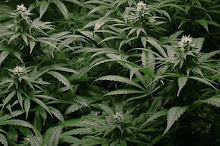Rob Kampia
Executive director, Marijuana Policy Project
Here is what I think we can reasonably accomplish by the end of 2013:
1. Decriminalize Marijuana in Vermont: Gov. Pete Shumlin (D), a strong supporter of decriminalizing marijuana, partially campaigned on the issue and easily won re-election on November 6 with 58% of the vote. The Vermont Llegislature is poised to pass the bill he wants, so this legislation could become law by this summer.
2. Legalize Medical Marijuana in New Hampshire: Incoming Gov. Maggie Hassan (D) is a strong supporter of medical marijuana, so we expect her to sign a medical marijuana bill similar to those vetoed by former Gov. John Lynch (D) in 2009 and 2012.
3. Build Support for Legalization in the Rhode Island Legislature: We successfully legalized medical marijuana and decriminalized marijuana possession in Rhode Island in 2009 and 2012, respectively. There is now considerable momentum to tax and regulate (T&R) marijuana like alcohol, so we need to ensure that Rhode Island's state legislature becomes the first to do so.
4. Increase Support for Legalization in California, Maine, and Oregon: There will be a sincere effort to pass T&R bills through the legislatures in these three states. Should they fall short, MPP and its allies will pursue statewide ballot initiatives in November 2016, at which time all three will be expected to pass.
5. Build Our Base of Support Online: People have said that the Internet is marijuana legalization's best friend, and this could not have been more evident than it was last year. Campaigns mobilized their supporters, organizations raised funds, and the public was able to follow the progress in real time. Prohibitionists, who have depended on the government for its largess for years, are now at a disadvantage. Private citizens simply do not want to donate to them, and most information about marijuana is now reaching the public without being run through their filter.
6. Continue the Steady Drumbeat in the Media: National and local media outlets are covering the marijuana issue more than ever before. Communicating to voters through news coverage is the most cost-efficient way to increase public support for ending marijuana prohibition, so we need to keep the issue in the spotlight.
7. Build Support for Medical Marijuana in Congress: There are already approximately 185 members of the U.S. House who want to stop the U.S. Justice Department from spending taxpayer money on raiding medical marijuana businesses in the 18 states (and DC) where medical marijuana is legal. We want to reach 218 votes on this amendment, thereby ensuring the amendment's transfer to the U.S. Senate for an up-or-down vote.
8. Build Support for Ending Marijuana Prohibition in Congress: Last year, the first-ever bill to end the federal government's prohibition of marijuana attracted 21 sponsors. Our goal is to expand the number of sponsors to more than two-dozen during the 2013-2014 election season.
Looking outside our borders, we're also seeing progress in Colombia, Uruguay, and Chile, which have all been steadily moving away from marijuana prohibition. Although this is good news, most members of the U.S. Congress do not care much about what South American countries think on marijuana policy, so we should temper the wonderful developments south of the U.S. border with limited expectations of what will happen in our nation's capital.
Ultimately, the U.S. is the primary exporter of prohibition around the world. If we can solve the problem here, the rest of the world will have far more freedom to conduct their own experiments with regulating marijuana.











